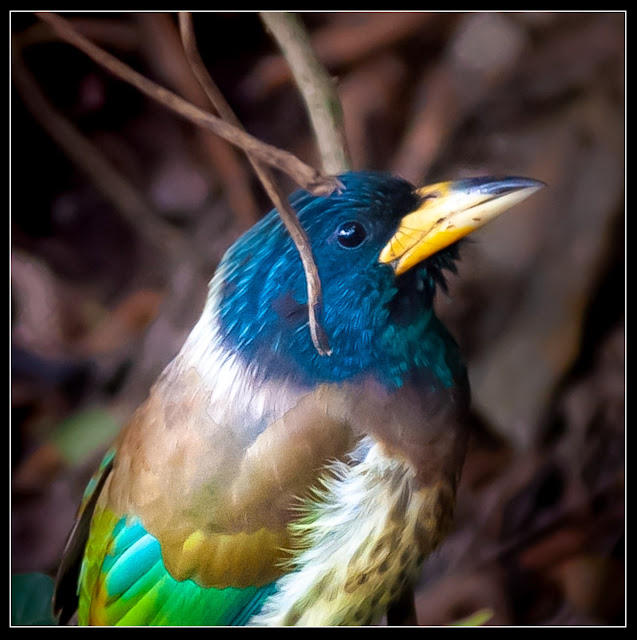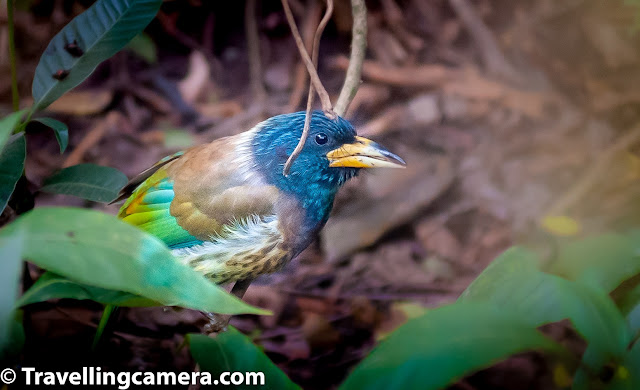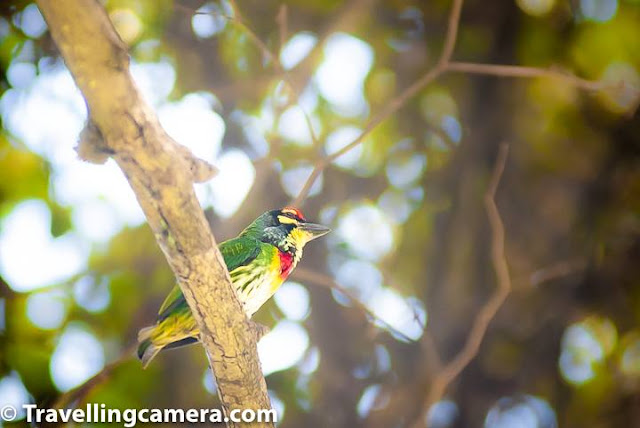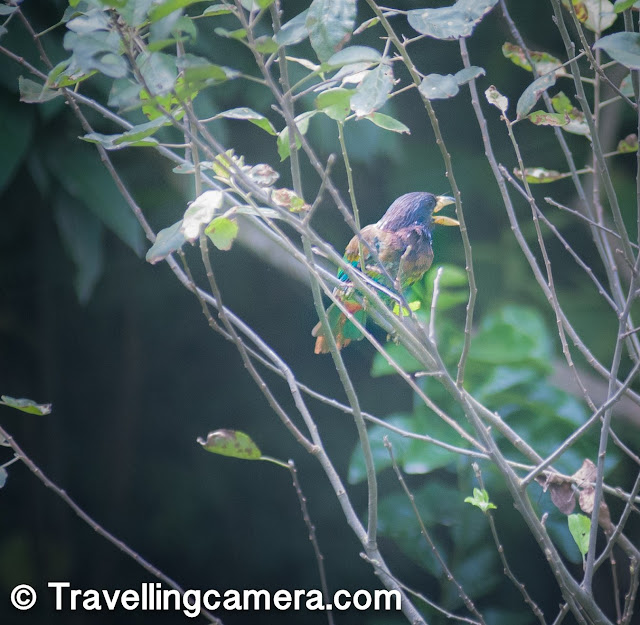 |
| Portrait of the Great Barbet |
The word Barbet is comparatively new in my vocabulary. I came across it about two years back when I happened to spot a large colorful bird on the banks of the little stream that flows behind our house in Himachal. I managed to click a very bad picture of it, and somehow one of our much more learned friends was able to identify it despite the bad shot. The bird turned out to be the Great Barbet. And since then, somehow we keep coming across Barbets of different colors, shapes, and sizes.
 |
| Blue-throated Barbet |
The best thing about Barbets is that you spend a large part of your life being unaware of their existence, but once you learn about them, you see them everywhere. And you see different varieties of them.
 |
| Great Barbet |
And that is the reason why Barbets are our bird for the month of February. This is the time when your start getting a hint of the spring.You see new buds on plants, a hint of green where there was frozen ground. So in a way you are sensing the spring before really seeing it. Same goes for Barbets. You often hear them much before you actually see them. And if you are like us, you probably know the sound, but would not realize that it belongs to one of the most beautiful bird you are ever going to see.
 |
| Blue-throated Barbet |
Barbets get their names from the bristles around their large beaks. Almost all barbets are bright and colorful and, therefore, are sometimes caged as pets. Barbets have heavy heads and plump bodies. However, the species is adaptable and resilient and at present none of the Asian species are threatened.
 |
| Coppersmith Barbet |
One of the barbets that I have special love for is the Brown-headed Barbet. This bird is commonly found all over Delhi and you can often hear its call echoing during the day. The fact that a pair of brown-headed barbets lives on the peepal tree right behind our house makes them all the more special. Following is an audio I found on the Internet that records the Brown-headed Barbet's call. Does it sound familar?
 |
| Coppersmith Barbet |
The other barbet that we saw is the Coppersmith Barbet. This tiny little colorful bird is widespread all across India, but we saw it in Ayuthhaya. Thailand. The Barbet is so called because its call is similar to the sound a coppersmith makes when striking a piece of metal with a hammer. At one glance, this bird looks like a woodpecker and it also behaves like one, pecking away on tree trunks.
Click this to listen to the Coppersmith Barbet's call.
The Coppersmith Barbet has a crimson patch on its forehead and another one on its throat, and that is why it is also known as the crimson-headed barbet. It has a yellow eye-patch and the rest of its body is green and yellow. Compared to the Great Barbet, the Coppersmith Barbet is really tiny. A little aside about barbets is that the tiniest of barbets are known as Tinkerbirds and are only found in Africa.
The next Barbet we chanced upon was during one of our recent visits to Himachal Pradesh. We spotted a bright blue and green bird feasting upon the Lonku (Chayote) fruit growing on a vine my father-in-law had planted. As this barbet also had a crimson patch on its forehead, I first thought it was a Coppersmith Barbet. However, this bird was much bigger.
 |
| Portrait of a Blue-throated Barbet |
Some search on the Internet revealed that it was the Blue-throated Barbet. Throughout our stay the only activity we saw this bird do was eating. And it made absolutely zero noise. Another observation was that this was a really restless bird and wouldn't stay at a single place for more than a few seconds. It would keep hopping to higher branches till it got out of the range of our basic camera and then relax. It would keep sitting there for hours, out in full view, keeping absolutely still. But yes, just out of the range of our camera.
 |
| Blue-throated Barbet |
Though the Blue-throated Barbets behind our home did not delight us with their calls, we know from our observations of Barbets that these aren't by nature quiet creatures. So I searched the internet again and got this video from youtube. You will notice that all Barbets sound different but their repeated calls have the same pattern.
 |
| Great Barbet in Dalhousie |
And then this month we seemed to have made the full circle. We saw the first Barbet we had ever seen again. The Great Barbet made another appearance behind our home. It too was attracted by the ripe Lonku fruits that lay scattered near the stream that flows behind our home.
 |
| Great Barbet at our First Sighting |
This time we managed to capture it in our camera. The bird is much more beautiful in reality though. This is really the largest Barbet you can find, and it sports all the colors Barbets are famous for - a little bit of green, a bit of blue, some purple, orange, yellow and also red. And here is a recording of its call.
This is our special post for our favorite bird - the Barbets. To find out about the bird we will be talking about next, i.e. in the month of March, please read our introduction to the series - Bird of the month - year 2020.


.jpg)
Comments